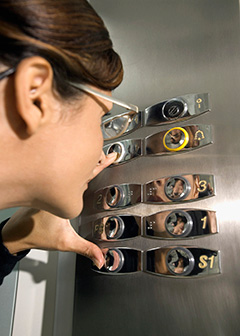Summary
Please enable javascript to play this video.
| Quick Facts: Elevator and Escalator Installers and Repairers | |
|---|---|
|
$106,580 per year
$51.24 per hour |
|
| High school diploma or equivalent | |
| None | |
| Apprenticeship | |
| 24,200 | |
| 5% (Faster than average) | |
| 1,200 | |
What Elevator and Escalator Installers and Repairers Do
Elevator and escalator installers and repairers install, maintain, and fix elevators, escalators, moving walkways, and other lifts.
Work Environment
Elevator and escalator installers and repairers often work in cramped areas inside crawl spaces and machine rooms, and they may work at heights in elevator shafts. Most elevator and escalator installers and repairers work full time. Repairers may be on call 24 hours a day or may need to work overtime.
How to Become an Elevator or Escalator Installer and Repairer
Elevator and escalator installers and repairers typically need a high school diploma or equivalent. Nearly all learn how to do the work through an apprenticeship. Most states require workers to be licensed.
Pay
The median annual wage for elevator and escalator installers and repairers was $106,580 in May 2024.
Job Outlook
Employment of elevator and escalator installers and repairers is projected to grow 5 percent from 2024 to 2034, faster than the average for all occupations.
About 2,000 openings for elevator and escalator installers and repairers are projected each year, on average, over the decade. Many of those openings are expected to result from the need to replace workers who transfer to different occupations or exit the labor force, such as to retire.
State & Area Data
Explore resources for employment and wages by state and area for elevator and escalator installers and repairers.
Similar Occupations
Compare the job duties, education, job growth, and pay of elevator and escalator installers and repairers with similar occupations.
More Information, Including Links to O*NET
Learn more about elevator and escalator installers and repairers by visiting additional resources, including O*NET, a source on key characteristics of workers and occupations.
 United States Department of Labor
United States Department of Labor









